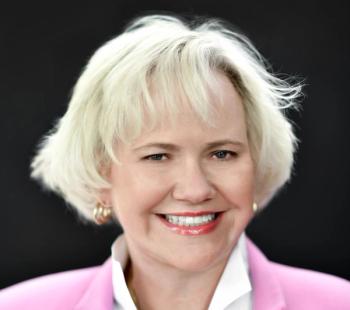
In a Leap Year, Leapfrog Group hopes to see big jumps in patient safety
Leah Binder, CEO of the Leapfrog Group, talks about patient safety, the link of safety to retaining workers, the patient experience, and why parking shouldn’t be an afterthought.
Leah Binder relishes the arrival of a Leap Year.
It makes sense, given her role as president and CEO of the
“Leap Year is Leapfrog’s year, and that means it's going to be safer for all of us,” Binder says.
The world has changed mightily since the last time the calendar included the date of Feb. 29. That was in 2020, and in early March of that year, the COVID-19 pandemic managed to upend the world, and consequently, the healthcare system.
Federal officials said the COVID-19 pandemic
Binder tells Chief Healthcare Executive® that she is encouraged by the progress she’s seeing in the reduction of infections.
“We've seen enormous progress from hospitals, in really coming back from the pandemic,” Binder says.
“The pandemic was a tough hit for hospitals,” she continues. “And I think they're doing a lot better now. And it's clear that they put a real focus on trying to restore operations and restore their level of safety, at least that they had prior to the pandemic. So, I'm optimistic. I do tend to be an optimist about these kinds of things. But I am optimistic just based on what I've been hearing.” (See part of our conversation with Leah Binder in this video. The story continues below.)
Binder is cautious to say that hospitals dealt with unprecedented challenges in the COVID-19 pandemic.
“I totally understand that the pandemic was a very tumultuous event for hospitals, I mean, tumultuous is probably an understatement,” Binder says. “And so it was a tremendously difficult experience for hospitals. And they were really on literally the front lines of our country dealing with an unprecedented emergency.
“That said, I think all of us want to feel that in the future, the safest place in the country, during a public health emergency, should be a hospital, that they're the best at dealing with a public health emergency,” she adds. “We really want to feel that way. And we really should feel that way.”
Binder is hoping hospitals examine what happened during the pandemic to take lessons for the next public health emergency.
The patient experience
Even as hospitals are showing progress in improving safety, the Leapfrog Group has found hospitals are lagging in the patient experience.
“Patient experience has been slower to recover,” Binder says. “And patient experience is a very important metric, because it has been correlated with performance in general on patient safety. There are studies that look at that. And so we're concerned about patient experience.”
Again, being an optimist, Binder says she hopes to see improvement in patient experience in hospitals as well. Still, hospitals are struggling to retain nurses, and Binder says that’s a “major, major issue” in some health systems struggling with communicating with patients or responding to them quickly. Patients notice when workers seem stressed due to being overworked and juggling a high number of patients.
“Workforce shortages are huge,” Binder says. “And it is clearly going to be shown in patient experience reports, because the first thing you notice when you're a patient is no one's answering the call button. I mean that is important to you.”
Binder notes that some hospitals are taking a closer look at the workload of nurses to try to ease some of their stress, including reducing some of their administrative burdens. Health systems should be looking at ways to help nurses practice at the top of their license, she says.
“I think that has many implications if we do that better,” Binder says. “That can improve care for patients.”
Safety and retention
Binder says patient safety, the patient experience, and the retention of nurses are all linked. Hospitals that do better in hiring and keeping nurses are likely going to fare better in protecting patients and giving them a better experience in the hospital. Conversely, nurses are less likely to leave hospitals if they are adequately staffed and they know leadership is concerned about the well-being of patients and staff.
“Patient safety is a workforce issue, and vice versa,” Binder says. “I don't think that many health leaders think of it that way.”
“I think health systems where the leadership really puts a priority on patient safety, we'll see retention improve for their workforce, because that aligns the workforce with their own values and their own purpose,” Binder says. “And those are fundamentals for any manager. And I hope that leaders and hospitals are recognizing that.”
‘Thinking about the patient first’
From Binder’s perspective, she sees a greater emphasis among hospital leadership on patient safety. She adds the caveat that given her role, hospital leaders are going to talk about their safety efforts.
“I guess I am seeing an uptick in the focus on patient safety, particularly after the pandemic,” Binder says. “I don't think it's where it should be. Sadly, I think there's other issues that tend to distract.”
Hospitals don’t always focus enough on patients in general.
“Always thinking about the patient first, every time you do anything … that's not routine in healthcare,” Binder says. “And that's really what you need to have a safe environment.”
Binder says that change could be forced upon health systems as more non-traditional players, including retailers such as Amazon, CVS and Walmart, expand their presence in healthcare. “Retail is focused on the consumer in a way that healthcare leaders really are not accustomed to,” Binder says.
Binder says she has heard from healthcare leaders that don’t put stock in patient experience reports because they don’t indicate enough about quality. But Binder points to a common complaint from patients: parking.
Some healthcare leaders dismiss patient complaints about a lack of convenience in parking, but it’s an area that’s a priority for retailers. “Their job is the customer,” Binder says.
If patients are saying parking is a problem, hospital leaders shouldn’t blow it off, she says. She says executives should realize, “if my patients think parking is a really important thing to their well-being, then it's really important to me.”
“That's a really different culture than we're accustomed to in healthcare,” Binder says. “But as we look at the introduction of retail into healthcare, I think health leaders are going to have to start to study that.”























































































